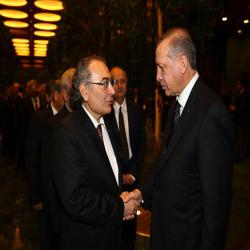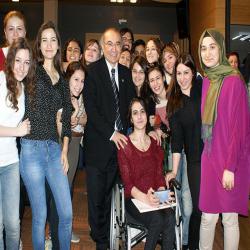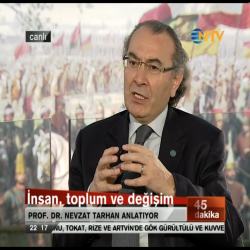In eight patients having medication-resistant severe bipolar depression, rTMS resulted in response to the therapy in 100 percent of patients. However, mania as an adverse effect occured in 37.5 of patients. Therefore, it seems that 62.5 of patients benefited from rTMS.
DISCUSSION
The fact that all eight patients having bipolar depression responded to rTMS is promising; however, high rate of switch to mania raises questions about the safety of this method.
There are case reports showing that transcranial magnetic stimulation has induced mania in patients suffering from bipolar depression (9,10,11,12,13). A study including both unipolar and bipolar patients compared rTMS and electroconvulsive therapy (ECT) and found significant difference neither in mania scores nor in improvement in depression (14). Another study conducted on 23 patients having bipolar depression who received either active or sham rTMS produced a trend but not statistically significant greater improvement in daily subjective mood ratings post-treatment, and no one switched to mania (15). Significant mood improvement was reported by bipolar disorder subjects who underwent an echo-planar magnetic resonance spectroscopic imaging (EP-MRSI) in comparison with those who underwent sham EP-MRSI and with healthy subjects who underwent actual EP-MRSI (16).
On the other hand, TMS was tried in the treatment of mania. Sixteen manic patients received right or left prefrontal TMS in a double-blind, controlled trial, and significantly more improvement was observed in those treated with right than with left stimulation(17) in contrast to the application of TMS in depression, which improves more significantly with left stimulation. In a later study 25 manic patients entered and 19 completed, either right active TMS or right sham TMS was applied and right TMS was no more effective than sham (18). The authors concluded that previous results reporting higher efficacy of right TMS were due to an effect of left TMS to worsen mania or to the fact that their patient population had much more psychosis than in the previous study (depression studies have reported that psychosis is a poor prognostic sign for TMS response). In an open and prospective study, nine manic patients treated with right prefrontal rapid TMS for four weeks showed a sustained reduction of manic symptoms (19). However, TMS of right prefrontal cortex has also been reported to induce mania (12).
Regarding literature and the present study, it seems that left prefrontal TMS leads to improvement in unipolar or bipolar depression while inducing mania; on the other hand, right prefrontal TMS may be useful for mania. High and low frequency TMS may cause opposite effects in brain and mood (20). The high rate of switch to mania in our trial may be due to higher doses given to the patients than reported in the literature. An article reviewing TMS in the treatment of mood disorder concluded that the antidepressant and antimanic effects of TMS depend on clinical considerations such as stimulus frequency, intensity, and magnetic coil placement; in addition, biological heterogeneity among the patients treated with TMS may also contribute to differing efficacy accross clinical trials (21).
CONCLUSION
rTMS may be an effective method in the treatment of bipolar depression. However, the fact that three patients out of eight switched to mania raises questions about its safety even though all of these patients were also taking antidepressant medications. The effects of rTMS on mood are related to stimulus frequency, intensity and coil placement. Elaboration of practical issues on the clinical application of rTMS may lead to an important development in the treatment of bipolar disorders. However, further studies conducted in larger samples of subjects in a controlled and double-blind design are needed.
REFERENCES
1.Pascual-Leone A, Rubio B, Pallardo F, Catala MD: Rapid-rate transcranial magnetic stimulation of left dorsolateral prefrontal cortex in drug-resistant depression. Lancet 1996; 348(9022):233-7.
2.George MS, Wassermann EM, Kimbrell TA, Little JT, Williams WE, Danielson AL, Greenberg BD, Hallett M, Post RM: Mood improvement following daily left prefrontal repetitive transcranial magnetic stimulation in patients with depression: a placebo-controlled crossover trial. Am J Psychiatry 1997; 154(12):1752-6.
3.Garcia-Toro M, Mayol A, Arnillas H, Capllonch I, Ibarra O, Crespi M, Mico J, Lafau O, Lafuente L: Modest adjunctive benefit with transcranial magnetic stimulation in medication-resistant depression. J Affect Disord 2001; 64(2-3):271-5.
4.George MS, Nahas Z, Molloy M, Speer AM, Oliver NC, Li X, Arana GW, Risch SC, Ballenger JC: A controlled trial of daily left prefrontal cortex TMS for treating depression. Biol Psychiatry 2000; 48(10):962-70.
5.Grunhaus L, Schreiber S, Dolberg OT, Polak D, Dannon PN: A randomized controlled comparison of electroconvulsive therapy and repetitive transcranial magnetic stimulation in severe and resistant nonpsychotic major depression. Biol Psychiatry 2003; 53:324-331.
6.Grunhaus L, Dannon PN, Schreiber S, Dolberg OH, Amiaz R, Ziv R, Lefkifker E: Repetitive transcranial magnetic stimulation is as effective as electroconvulsive therapy in the treatment of nondelusional major depressive disorder: an open study. Biol Psychiatry 2000; 47(4):314-24.
7.Pridmore S, Bruno R, Turnier-Shea Y, Reid P, Rybak M: Comparison of unlimited numbers of rapid transcranial magnetic stimulation (rTMS) and ECT treatment sessions in major depressive episode. Int J Neuropsychopharmacol 2000; 3(2):129-134.
8.Janicak PG, Dowd SM, Martis B, Alam D, Beedle D, Krasuski J, Strong MJ, Sharma R, Rosen C, Viana M: Repetitive transcranial magnetic stimulation versus electroconvulsive therapy for major depression: preliminary results of a randomized trial. Biol Psychiatry 2002; 51:659-67.
9.Garcia-Toro M: Acute manic symptomatology during repetitive transcranial magnetic stimulation in a patient with bipolar depression. Br J Psychiatry 1999 Nov; 175:491.
10.Nedjat S, Folkerts HW: Induction of a reversible state of hypomania by rapid-rate transcranial magnetic stimulation over the left prefrontal lobe. J ECT 1999 Jun; 15(2):166-8.
11.Dolberg OT, Schreiber S, Grunhaus L: Transcranial magnetic stimulation-induced switch into mania : a report of two cases. Biol Psychiatry 2001 Mar 1; 49(5):468-70.
12.Ella R, Zwanzger P, Stampfer R, Preuss UW, Muller-Siecheneder F, Moller HJ, Padberg F: Switch to mania after slow rTMS of the right prefrontal cortex. J Clin Psychiatry 2002 Mar; 63(3):249.
13.Sakkas P, Mihalopoulou P, Mourtzouhou P, Psarros C, Masdrakis C, Politis A, Christodoulou GN: Induction of mania by rTMS: a report of two cases. Eur Psychiatry 2003 Jun; 18(4):196-8.
14.Janicak PG, Dowd SM, Martis B, Alam D, Beedle D, Krasuski J, Strong MJ, Sharma R, Rosen C, Viana M: Repetitive transcranial magnetic stimulation versus electroconvulsive therapy for major depression: preliminary results of a randomized trial. Biol Psychiatry 2002 Apr 15; 51(8):659-67.
15.Nahas Z, Kozel, Li X, Anderson B, George MS: Left prefrontal transcranial magnetic stimulation (TMS) treatment of depression in bipolar affective disorder: a pilot study of acute safety and efficacy. Bipolar Disord 2003 Feb; 5(1):40-7.
16.Rohan M, Parow A, Stoll AL, Demopulos C, Friedman S, Dager S, Hennen J, Cohen BM, Renshaw PF: Low-field magnetic stimulation in bipolar depression using an MR-based stimulator. Am J Psychiatry 2004 Jan; 161(1);93-8.
17.Grisaru N, Chudakov B, Yaroslavsky Y, Belmaker RH: Transcranial magnetic stimulation in mania: a controlled study. Am J Psychiatry 1998 Nov; 155(11):1608-10.
18.Kaptsan A, Yaroslavsky Y, Appelbaum J, Belmaker RH Grisaru N: Right prefrontal TMS versus sham treatment of mania: a controlled study. Bipolar Disord 2003 Feb; 5(1):36-9.
19.Michael N, Erfurth A: Treatment of bipolar mania with right prefrontal rapid transcranial magnetic stimulation. J Affect Disord 2004 Mar; 78(3):253-7.
20.Speer AM, Kimbrell TA, Wasserman EM, Repella J, Willis MW, Herscovitch P, Post RM: Opposite effects of high and low frequency rTMS on regional brain activity in depressed patients. Biol Psychiatry 2000 Dec; 48(12):1133-41.










